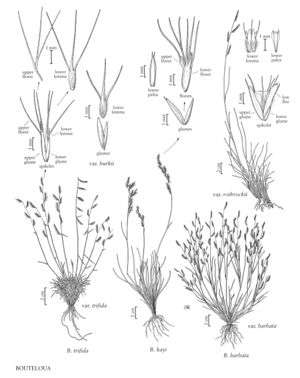Difference between revisions of "Bouteloua barbata var. rothrockii"
FNA>Volume Importer |
FNA>Volume Importer |
||
| Line 7: | Line 7: | ||
|synonyms={{Treatment/ID/Synonym | |synonyms={{Treatment/ID/Synonym | ||
|name=Bouteloua rothrockii | |name=Bouteloua rothrockii | ||
| − | |authority= | + | |authority= |
| + | |rank=species | ||
}} | }} | ||
|hierarchy=Poaceae;Poaceae subfam. Chloridoideae;Poaceae tribe Cynodonteae;Bouteloua;Bouteloua subg. Chondrosum;Bouteloua barbata;Bouteloua barbata var. rothrockii | |hierarchy=Poaceae;Poaceae subfam. Chloridoideae;Poaceae tribe Cynodonteae;Bouteloua;Bouteloua subg. Chondrosum;Bouteloua barbata;Bouteloua barbata var. rothrockii | ||
| Line 19: | Line 20: | ||
-->{{Treatment/Body | -->{{Treatment/Body | ||
| − | |discussion=<p>Bouteloua barbata var. rothrockii grows on dry slopes and sandy flats, mostly at 750-1700 m. It grows throughout the southwestern United States and Mexico, sometimes covering large areas. It used to be the most important forage grass in southern Arizona and neighboring regions.</p><!-- | + | |discussion=<p><i>Bouteloua barbata </i>var.<i> rothrockii</i> grows on dry slopes and sandy flats, mostly at 750-1700 m. It grows throughout the southwestern United States and Mexico, sometimes covering large areas. It used to be the most important forage grass in southern Arizona and neighboring regions.</p><!-- |
| − | --><p>Bouteloua barbata var. rothrockii resembles B. parryi var. parryi, but can be easily distinguished from that taxon by the lack of papillose-based hairs on the keels of its upper glumes.</p> | + | --><p><i>Bouteloua barbata </i>var.<i> rothrockii</i> resembles <i>B. parryi</i> <i></i>var.<i> parryi</i>, but can be easily distinguished from that taxon by the lack of papillose-based hairs on the keels of its upper glumes.</p> |
|tables= | |tables= | ||
|references= | |references= | ||
| Line 29: | Line 30: | ||
-->{{#Taxon: | -->{{#Taxon: | ||
name=Bouteloua barbata var. rothrockii | name=Bouteloua barbata var. rothrockii | ||
| − | |||
|authority=(Vasey) Gould | |authority=(Vasey) Gould | ||
|rank=variety | |rank=variety | ||
| Line 36: | Line 36: | ||
|basionyms= | |basionyms= | ||
|family=Poaceae | |family=Poaceae | ||
| − | |illustrator=Linda A. Vorobik | + | |illustrator=Linda A. Vorobik;Cindy Roché |
| + | |illustration copyright=Utah State University | ||
|reference=None | |reference=None | ||
|publication title= | |publication title= | ||
|publication year= | |publication year= | ||
|special status= | |special status= | ||
| − | |source xml=https:// | + | |source xml=https://jpend@bitbucket.org/aafc-mbb/fna-data-curation.git/src/f50eec43f223ca0e34566be0b046453a0960e173/coarse_grained_fna_xml/V25/V25_895.xml |
|subfamily=Poaceae subfam. Chloridoideae | |subfamily=Poaceae subfam. Chloridoideae | ||
|tribe=Poaceae tribe Cynodonteae | |tribe=Poaceae tribe Cynodonteae | ||
Revision as of 20:38, 16 December 2019
Plants short-lived perennials; not stoloniferous. Culms 25-60 (75) cm, stiffly erect or slightly geniculate-spreading basally; ligules 0.1-0.5 mm; blades 6-10 cm long, 1-4 mm wide. Panicles (3.5)5-25 cm, with 3-8 branches; branches 15-30 mm, scabrous, with 35-50 (55) spikelets. 2n = 40.
Discussion
Bouteloua barbata var. rothrockii grows on dry slopes and sandy flats, mostly at 750-1700 m. It grows throughout the southwestern United States and Mexico, sometimes covering large areas. It used to be the most important forage grass in southern Arizona and neighboring regions.
Bouteloua barbata var. rothrockii resembles B. parryi var. parryi, but can be easily distinguished from that taxon by the lack of papillose-based hairs on the keels of its upper glumes.
Selected References
None.
